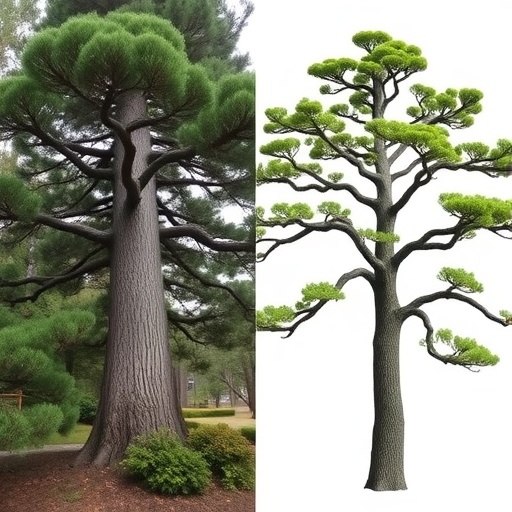In the densely forested landscapes of Japan and Taiwan thrives the hinoki cypress (Chamaecyparis obtusa), a species of immense ecological and commercial significance. Revered for its durable timber, this tree has shaped architectural and cultural heritage across East Asia. Recent advancements in population genetic analysis have unraveled the intricate evolutionary and biogeographical history of the Japanese and Taiwanese variants of hinoki cypress, shedding light on their divergence and adaptation across varying climates. The implications of these findings could revolutionize conservation strategies and forest management practices in the region, ensuring the preservation of genetic diversity essential for resilience to future climatic shifts.
Hinoki cypress, a foundational species in Japanese forestry, ranks second only to sugi cedar in terms of forest plantation area and timber yield. Native hinoki forests stretch broadly from the temperate north of Fukushima Prefecture down to the subtropical island of Yakushima in southern Japan. In contrast, Taiwanese hinoki represents a closely related variety historically prized for its larger trunk dimensions. Its timber was a valued import to Japan, particularly sought for shrine and temple construction, underscoring the economic and cultural nexus between the regions.
The crux of the recent study centered on a comprehensive genetic assessment of hinoki populations distributed throughout the natural ranges of both Japanese and Taiwanese forms. Researchers employed advanced molecular markers to parse the population structure, genetic diversity, and historical demographic trends. The resultant phylogeographic patterns elucidated a clear genetic bifurcation between the two populations, with divergence estimated at approximately one million years ago, coinciding with the early Pleistocene epoch.
Underlying this divergence lies the geological history of the Ryukyu Arc—a volcanic island chain connecting southern Kyushu to Taiwan. During glacial periods, land bridges formed, facilitating species dispersals. However, the subsequent retreat of these land connections led to allopatric speciation events driven by geographic isolation. This pivotal vicariance event is fundamental in understanding the deep genetic split observed between Japanese and Taiwanese hinoki cypress populations.
Climatic adaptations further distinguish the two lineages. Japanese hinoki cypress populations exhibit traits suited to warm, humid summers, reflective of the temperate Japanese climate where precipitation is largely concentrated during the summer months. Conversely, Taiwanese hinoki thrives in regions with colder, rainier winters, suggesting selective pressures have favored cold tolerance and a phenology adapted to winter precipitation regimes. These ecological specializations underscore the evolutionary trajectories shaped by regional climate variability.
Within Japan itself, the genetic tapestry of hinoki populations is far from uniform. Marked genetic differentiation aligns with geographic regions: island populations in Yakushima exhibit distinct genomic signatures; central and western Honshu populations cluster separately from those in central and northern Honshu. These patterns mirror historical population expansions and contractions, with a genetic footprint indicative of an overall increasing trend in population sizes. Peripheral populations at the northern limits of Fukushima and southern reaches in Yakushima demonstrate strikingly unique genetic profiles, spotlighting them as critical reservoirs of genetic variation.
Taiwan’s hinoki populations, however, deviate from this regional structuring pattern. Genetic analyses reveal a lack of clear geographic differentiation, instead indicating widespread fragmentation and decline. This contrasts sharply with the Japanese populations and signals possible recent demographic contractions or habitat disruptions, emphasizing the heightened vulnerability of Taiwanese hinoki and the urgent need for targeted conservation.
Current forestry regulations in Japan reflect an awareness of climatic heterogeneity by dividing seedling transfer regions into three categories, principally based on macroclimatic parameters. However, this study challenges the adequacy of such a classification system by demonstrating that genetic regional characteristics are paramount in maintaining local adaptations. The interbreeding of genetically distinct populations—termed outbreeding depression—poses a threat by potentially eroding the environmental fitness of progeny, reducing resilience against local climatic stressors.
These genetic findings advocate for a refined regulatory framework guiding seedling transplantation and reforestation. Preservation of genetic integrity through management rooted in molecular insights will enhance the adaptive capacity of natural forests, safeguarding them as vital genetic resources in the face of global climate change. The nuanced understanding of genetic diversity and divergence elucidated by this research offers a blueprint for integrating evolutionary biology with practical forest management.
From a biogeographical perspective, the study illustrates how ancient land connections and climatic oscillations have sculpted the distribution and genetic differentiation of East Asian flora. The Pleistocene epoch, characterized by recurrent glaciations and fluctuating sea levels, emerges as a crucial period underpinning the evolutionary history of the hinoki cypress. Such insights contribute to a broader understanding of how past geological and climatic events continue to influence present-day biodiversity patterns.
The conservation prioritization outlined by this research spotlights range-edge populations with unique genetic attributes. These marginal populations, often isolated and genetically distinct, harbor alleles potentially critical for adaptation to environmental extremes. Consequently, management strategies must reconcile the dual objectives of conserving genetic diversity while maintaining population connectivity to mitigate inbreeding risks.
By integrating genomic data with ecological context, the study pioneers a paradigm shift in forest genetics research. Molecular techniques enable disentangling complex evolutionary histories, revealing patterns invisible to traditional morphological or geographic assessments. This holistic approach empowers conservationists and forest managers to tailor interventions that preserve evolutionary legacy and bolster ecosystem stability.
In conclusion, the genetic dichotomy between Japanese and Taiwanese hinoki cypress embodies a profound evolutionary narrative shaped by geological vicariance and climatic adaptation. This research not only enhances scientific comprehension of species divergence and population genetics but also furnishes indispensable guidelines for conservation and sustainable forest resource management. As climate change accelerates, harnessing such knowledge becomes ever more critical to safeguard forest biodiversity and the cultural heritage intertwined with these majestic trees.
Subject of Research: Genetic divergence, population structure, and evolutionary history of Japanese and Taiwanese hinoki cypress (Chamaecyparis obtusa)
Article Title: The Historical Biogeography of Divergence in the Relict Cypress Chamaecyparis obtusa, and the Implications for Conservation and Management in East Asia
News Publication Date: 30-Sep-2025
Web References: https://doi.org/10.1002/ece3.72240
Image Credits: University of Tsukuba
Keywords: Forestry, Trees, Climate change, Genetic diversity




